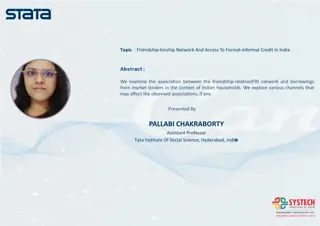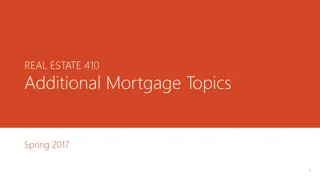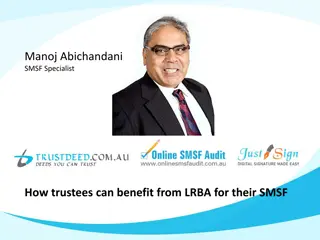Understanding Different Types of Borrowing and Overdrafts
Explore the differences between various types of borrowing such as loans, overdrafts, credit card borrowing, and payday loans. Learn how to differentiate between quoted interest rates and effective annual rates, secured and unsecured borrowing, and how to calculate effective annual rates. Discover the nuances of overdrafts, how they work, authorized vs. unauthorized overdrafts, and the potential pitfalls associated with them through practical exercises and examples.
Download Presentation

Please find below an Image/Link to download the presentation.
The content on the website is provided AS IS for your information and personal use only. It may not be sold, licensed, or shared on other websites without obtaining consent from the author. Download presentation by click this link. If you encounter any issues during the download, it is possible that the publisher has removed the file from their server.
E N D
Presentation Transcript
CISI Financial Products, Markets & Services Topic Other Retail Financial Products (10.1) Loans cisi.org
Learning Objectives 1. Know the difference between bank loans, overdrafts, credit card borrowing and payday loans 2. Know the difference between the quoted interest rate on borrowing and the effective annual rate of borrowing 3. Know the difference between secured and unsecured borrowing 4. Be able to calculate the effective annual rate of borrowing, given the quoted interest rate and frequency of payment cisi.org
Borrowing Money The traditional banking model involves financial institutions taking deposits from customers before using a proportion of that money to lend to other customers. Individuals can borrow money from financial institutions in one of three ways: OVERDRAFTS CREDIT CARDS LOANS Each type of borrowing is suitable for different purposes. If you get it wrong, you could pay out a lot more than you should have. cisi.org
Overdrafts In 1972, Gordon Brown tried to pay for his university lodgings with a cheque for 3 Refer to Drawer is bank-speak for this person has insufficient funds in his account to pay the cheque cisi.org
Overdrafts Unlike in 1972, today it would be unusual for a bank to bounce a cheque for a relatively small sum. The bank is more likely to honour the cheque while charging the account holder a fee and a high rate of interest for going overdrawn . There are two types of overdraft: Authorised Unauthorised An overdraft limit is agreed in advance with the bank: An overdraft limit has not been agreed in advance with the bank or the agreed limit has been exceeded: Charge interest at a lower rate Some banks will not charge any interest if a person is overdrawn by a small amount Charge interest at a higher rate Often charged a fee cisi.org
Authorised and Unauthorised Overdrafts Source: www.thisismoney.co.uk ,2011 If not paid off promptly, unauthorised overdraft fees can accumulate and push up the overdraft to many times the original sum owed to the bank. cisi.org
Using overdrafts Exercise Using the worksheet, read about Hot Dog Express Ltd and its overdraft and answer the questions that follow. Question 1 I = p x r x t I = 7750 x 0.016833333 x 6 I = 747.87 Question 2 I = p x r x t P = I/(r x t) P = 747.87/(0.0165416667 x 6) P = 747.87/0.09924996 P = 7,535.22 cisi.org Rhino rugby overdraft
Loans Hot Dog Express Ltd is worried that its bank might withdraw the overdraft facility without any warning. It does not want to suffer the same problems as Rhino Rugby. Hot Dog Express decides to take out a loan at 13% for 10,000 for a fixed, three-year period. What are the advantages and disadvantages of using a loan instead of an overdraft? Pros: As long as Hot Dog Express complies with the conditions of the loan agreement, the bank cannot demand repayment of the loan before the term expires. Cons: Hot Dog Express has to borrow the full amount of the loan, which is more than it needs for most of the time It pays interest on the full amount of the loan The interest rate is only 13.0% - much cheaper than the overdraft rate of 19.3% It may have to offer security to prove it can repay the loan cisi.org
Loans Loans can be subdivided into two groups: Unsecured Secured Loan is not linked to the item that is purchased with the loan The bank gets the right to seize the borrower s asset if the borrower defaults on the terms of the loan: Typically used to purchase consumer goods The borrower fails to make several interest payments The borrower fails to make repayments of the principle (original sum borrowed) Student loans are also unsecured and are repaid after university. The lender will check the creditworthiness of the borrower: Assess whether he or she can afford to repay the loan and interest over the agreed term from their income given their existing outgoings. (Credit history checks) Mortgages are examples of secured loans. The bank is less likely to lose its money: The risk of default is lower The lower the risk, the lower the interest rate the bank is likely to charge It can be difficult for the lender to enforce the loan agreement if the borrower fails to pay legal proceedings have to be started cisi.org
Payday Loans Payday Lending is when small cash loans aremade to individuals. Initially, they were meant to be paid back by an individual the next time they were paid, or at the end of the month. The term payday loans is now used to describe a range of different products but they have some common features: Short-term unsecured loans for periods up to 12 months although most are for periods of 31 days or less; they are for relatively small amounts new borrowers can typically borrow between 100 and 500 Repeat borrowers may be able to borrow more but rarely more than 1,000 New rules on payday loans: Price cap on the rate of interest Capped at 0.8% per day If borrowers do not repay their loans on time, default charges must not exceed 15 and the maximum cost is capped at 100% of the original sum cisi.org
Bad Credit History? There are plenty of firms willing to lend money to people with bad credit ratings at a price Credit cards are much more widely used in the UK than in other European countries. Most people cannot live without them. Unfortunately, a lot of businesses use them too. cisi.org
Using Credit Cards A wide variety of retail goods such as food, electrical goods, petrol and cinema tickets can be paid for using a credit card. How they work... The retailer is paid by the credit card company for the goods sold The credit card company charges the retailer a small fee, but this enables the store to sell goods to customers using their credit cards. Customers are typically sent a monthly statement by the credit card company. Customers can choose to pay all the money owed to the credit card company, or just a percentage of the total sum owed. cisi.org
Paying interest on Credit Cards Interest is charged on the balance owed by the customer. The interest rate charged on credit cards is relatively high compared to other forms of borrowing If a customer pays the full balance each month, he is borrowing interest-free. It is also common for credit card companies to offer 0% interest to new customers for balances transferred from other cards and for new purchases for a set period, often six months. The bait... Credit card interest is so profitable to banks that they entice people to switch their outstanding balance over to a new card. The bait is 0% interest charged on transferred balances for an extended period. The catch is there s a fee that has to be paid on the balance transferred in this case 2.98%. cisi.org
Interest Rates The costs of borrowing (mainly interest) vary depending on the form of borrowing, how long the money is required for, the security offered and the amount borrowed. CREDIT CARDS UNAUTHORISED OVERDRAFT AUTHORISED OVERDRAFT MORTGAGE cisi.org
Confusing Interest Rates Quoted Rate Annual Percentage Rate the advertised rate of interest highlighted by the lender. This often account for interest if it was charged once a year. EAR Effective Annual Rate the annual rate of interest assuming the addition of interest charges to the principal sum (i.e. outstanding balance) which are more frequent than once a year. This highlights the true rate of interest paid by the customer. Under UK law, all lenders have to tell you what their APR is before you sign. The APR doesn t include all the costs associated with a credit agreement such as: charges for late or missed payments balance transfer fees on a credit card charges for optional payment protection insurance cisi.org
Confusing Interest Rates It is important to understand what sort of interest rate is being quoted by a lender A credit card company might advertise an annual rate of 3.99% on the balance you transfer to them: Interest is charged monthly 3.99% divided by 12 months = 0.3325% per month on outstanding balance This interest is added to the balance, making it bigger each month Interest is then charged the next month on the larger balance To find out what the true interest rate is, use the following formula: Take 0.3325% and express this as 1.003325 Then multiply to the power of 12 months: 1.00332512 = 1.04064 1.04064 re-expressed as a percentage is 4.06% Effective Annual Rate (EAR) is 4.06% cisi.org
Calculating EAR from the Quoted Rate The Moneybags Credit Card Company quotes its interest rate at 12% per annum, charged on a quarterly basis. Use your worksheet to calculate the effective annual rate: 1. 12% 4 = 3% interest charged every 3-months 2. Turn 3% interest into a decimal: 3 100 = 0.03 3. Add 1 to the decimal = 1.03 4. Multiply the number to the power of the number of periods interest is charged: 1.03 = 1.03 x 1.03 x 1.03 x 1.03 1.03 = 1.1255088 5. Minus the 1 = 0.1255088 6. Turn 0.1255088 back into a % - 0.1255088 x 100 = 12.55% EAR cisi.org























